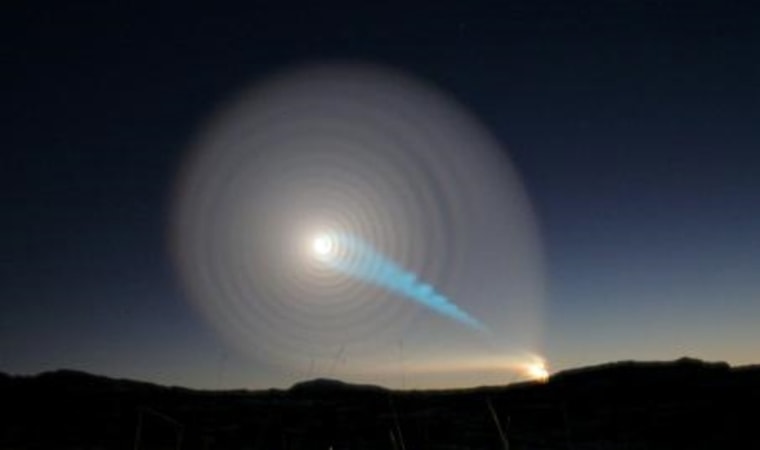A spectacular spiral light show in the sky above Norway on Wednesday was caused by a Russian missile that failed just after launch, according to Russia's defense ministry.
When the rocket motor spun out of control, it likely created the heavenly spiral of white light near where the missile was launched from a submarine in the White Sea.
The Russian Defense Ministry confirmed that a Bulava ballistic missile test had failed.
"It has been established ... that the missile's first two stages worked as normal, but there was a technical malfunction at the next, third, stage of the trajectory," Reuters quoted a Defense Ministry spokesman as saying.
Paal Brekke, a senior adviser at the Norwegian Space Centre Drammensvn, told Space.com that the cloud was "very spectacular."
"When we looked at the videos people submitted to the media, we quickly concluded that it looked like a rocket or missile out of control, thus the spiraling effect," Brekke said. "I think this is the first time we have seen such a display from a launch failure."
The phenomenon was seen by people all over northern Norway.
"It was a fairly stunning display, and we were really surprised to see it so well-observed," Brekke said.
Viewers described an eerie white cloud with a piercing blue-green beam coming out of it.
"It consisted initially of a green beam of light similar in color to the aurora with a mysterious rotating spiral at one end," Nick Banbury of Harstad, Norway, told Spaceweather.com. "This spiral then got bigger and bigger until it turned into a huge halo in the sky with the green beam extending down to Earth."
Banbury said he saw the lights on his way to work between 7:50 and 8 a.m. local time, or 1:50 to 2 a.m. ET Wednesday.
"We are used to seeing lots of auroras here in Norway, but this was different," he said.
Before the missile test was confirmed, many people suggested the bright light pattern might have been a UFO. Russia finally admitted to the accident, which is an embarrassing mishap for a rocket that had already failed six of 13 previous tests, according to the BBC.
The Bulava missile is designed to carry six individually targeted nuclear warheads over a range of up to 6,200 miles (10,000 km), the BBC reported. The missile had been touted as Russia's newest technological breakthrough to support its nuclear deterrent, but the numerous failures have led to second thoughts.
"This is a catastrophe ... Huge funds were siphoned off from Russia's moribund navy for the Bulava project. In fact, billions of dollars have been flushed down the drain," Alexander Khramchikhin, chief analyst at the Moscow-based Institute of Military and Political Analysis, told Reuters.
Analysts criticize Moscow's hurry to build the Bulava, as it already has a highly reliable Soviet-built Sineva submarine-based ballistic missile. They also question awarding the Bulava contract to the Moscow Institute of Thermal Technology, which has never before built missiles for submarines.
This report was supplemented with information from Reuters.
